International Journal of Intelligent Systems and Applications @ijisa
Статьи журнала - International Journal of Intelligent Systems and Applications
Все статьи: 1214
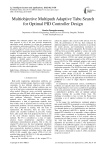
Multiobjective Multipath Adaptive Tabu Search for Optimal PID Controller Design
Статья научная
The multipath adaptive tabu search (MATS) has been proposed as one of the most powerful metaheuristic optimization search techniques for solving the combinatorial and continuous optimization problems. The MATS employing the adaptive tabu search (ATS) as the search core has been proved and applied to various real-world engineering problems in single objective optimization manner. However, many design problems in engineering are typically multiobjective under complex nonlinear constraints. In this paper, the multiobjective multipath adaptive tabu search (mMATS) is proposed. The mMATS is validated against a set of multiobjective test functions, and then applied to design an optimal PID controller of the automatic voltage regulator (AVR) system. As results, the mMATS can provide very satisfactory solutions for all test functions as well as the control application.
Бесплатно
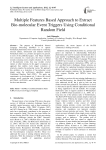
Статья научная
The purpose of Biomedical Natural Language Processing (BioNLP) is to capture biomedical phenomena from textual data by extracting relevant entities, information and relations between biomedical entities (i.e. proteins and genes). In general, in most of the published papers, only binary relations were extracted. In a recent past, the focus is shifted towards extracting more complex relations in the form of bio-molecular events that may include several entities or other relations. In this paper we propose an approach that enables event trigger extraction of relatively complex bio-molecular events. We approach this problem as a detection of bio-molecular event trigger using the well-known algorithm, namely Conditional Random Field (CRF). We apply our experiments on development set. It shows the overall average recall, precision and F-measure values of 64.27504%, 69.97559% and 67.00429%, respectively for the event detection.
Бесплатно
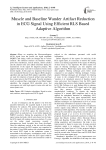
Статья научная
When we acquiring the Electrocardiogram (ECG) signal from the person, the signal amplitude (PQRST) and timing values are changes due to various artefacts. The different artefacts are Baseline wander, power line interference, muscle artefact, motion artefact and the channel noise also added sometimes during the transmission of the signal for diagnosis purpose. The adaptive filters play vital role for reduction of noise in the desired signals. In this paper we proposed, block based error normalized Recursive Least Square (RLS) adaptive algorithm and sign based RLS adaptive algorithm, which are used for reduction of muscle artifact noise and base line wander noise in the ECG signal. From the simulation result we analyzed that, comparing to Least Mean Square algorithm, the proposed RLS algorithm gives fast convergence rate with high signal to noise ratio and less mean square error.
Бесплатно
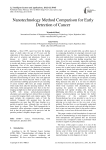
Nanotechnology Method Comparison for Early Detection of Cancer
Статья научная
Since 1999, cancer has been the leading cause of death under the age of 85 years and the eradication of this disease has been the long sought-after goal of scientists and physicians. Cancer is a disease in which abnormal cells divide uncontrollably. These abnormal cells have the ability to invade and destroy normal body cells, which is life threatening. One of the most important factors in effective cancer treatment is the detection of cancerous tumour cells in an early stage. Nanotechnology brings new hope to the arena of cancer detection research, owing to nanoparticles’ unique physical and chemical properties, giving them the potential to be used in the detection and monitoring of cancer. One such approach is quantum dots based detection which is rapid, easy and economical enabling quick point-of-care screening of cancer markers. QDs have got unique properties which make them ideal for detecting tumours. On the other hand, Gold nanoparticles have been in the bio-imaging spotlight due to their special optical properties. Au-NPs with strong surface-plasmon-enhanced absorption and scattering have allowed them to emerge as powerful imaging labels and contrast agents. This paper includes the comparative study of both the methods. Compared with quantum dots, the gold-nanoparticles are more than 200 times brighter on a particle-to-particle basis, although they are about 60 times larger by volume. Thus, Gold nanoparticles in suspension, offers advantages compared with quantum dots in that the gold appears to be non-toxic and the particles produce a brighter, sharper signal.
Бесплатно
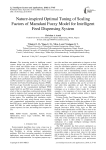
Статья научная
The increasing trends in intelligent control systems design has provide means for engineers to evolve robust and flexible means of adapting them to diverse applications. This tendency would reduce the challenges and complexity in bringing about the appropriate controllers to effect stability and efficient operations of industrial systems. This paper investigates the effect of two nature inspired algorithms, Genetic Algorithm (GA) and Particle Swarm Optimization (PSO), on PID controller for optimum tuning of a Fuzzy Logic Controller for Poultry Feed Dispensing Systems (PFDS). The Fuzzy Logic Controller was used to obtain a desired control speed for the conceptualized intelligent PFDS model. Both GA and PSO were compared to investigate which of the two algorithms could permit dynamic PFDS model to minimize feed wastage and reduce the alarming human involvement in dispensing poultry feeds majorly in the tropics. The modelling and simulation results obtained from the study using discrete event simulator and computational programming environment showed that PSO gave a much desired results for the optimally tuned FLC-PID, for stable intelligent PFDS with fast system response, rise time, and settling time compared to GA.
Бесплатно
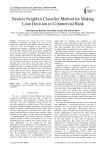
Nearest Neighbor Classifier Method for Making Loan Decision in Commercial Bank
Статья научная
Bank plays the central role for the economic development world-wide. The failure and success of the banking sector depends upon the ability to proper evaluation of credit risk. Credit risk evaluation of any potential credit application has remained a challenge for banks all over the world till today. Artificial neural network plays a tremendous role in the field of finance for making critical, enigmatic and sensitive decisions those are sometimes impossible for human being. Like other critical decision in the finance, the decision of sanctioning loan to the customer is also an enigmatic problem. The objective of this paper is to design such a Neural Network that can facilitate loan officers to make correct decision for providing loan to the proper client. This paper checks the applicability of one of the new integrated model with nearest neighbor classifier on a sample data taken from a Bangladeshi Bank named Brac Bank. The Neural network will consider several factors of the client of the bank and make the loan officer informed about client’s eligibility of getting a loan. Several effective methods of neural network can be used for making this bank decision such as back propagation learning, regression model, gradient descent algorithm, nearest neighbor classifier etc.
Бесплатно

NegMiner: An Automated Tool for Mining Negations from Electronic Narrative Medical Documents
Статья научная
Mining negations from electronic narrative medical documents is one of the prominent data mining applications. Since medical documents are freely written, it is impossible to consider all possible sentence structures in advance and so frequent update of mining algorithms is inevitable. Unfortunately most of the proposed algorithms in the literature are too complex to be easily updated. Besides, most of them cannot be easily ported to other natural languages. The simple NegEx algorithm utilizes only two regular expressions and sets of terms to mine negations from narrative medical documents and so does not suffer from these shortcomings. Meanwhile, it has shown impressive mining results and so it is the most widely adopted algorithm. This paper proposes the Negation Mining (NegMiner) tool to address some of the shortcomings of the NegEx algorithm. The NegMiner exploits some basic syntactic and semantic information to deal with contiguous and multiple negations. It is a user-friendly tool that facilitates the task of knowledge base update and the task of document analysis through the use of PDF files. This also makes it able to deal with the existence of a medical finding several times in a single sentence. Experimental results have shown the superiority of the mining results of the NegMiner in comparison to the simulated NegEx algorithm.
Бесплатно
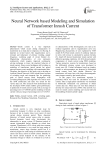
Neural Network based Modeling and Simulation of Transformer Inrush Current
Статья научная
Inrush current is a very important phenomenon which occurs during energization of transformer at no load due to temporary over fluxing. It depends on several factors like magnetization curve, resistant and inductance of primary winding, supply frequency, switching angle of circuit breaker etc. Magnetizing characteristics of core represents nonlinearity which requires improved nonlinearity solving technique to know the practical behavior of inrush current. Since several techniques still working on modeling of transformer inrush current but neural network ensures exact modeling with experimental data. Therefore, the objective of this study was to develop an Artificial Neural Network (ANN) model based on data of switching angle and remanent flux for predicting peak of inrush current. Back Propagation with Levenberg-Marquardt (LM) algorithm was used to train the ANN architecture and same was tested for the various data sets. This research work demonstrates that the developed ANN model exhibits good performance in prediction of inrush current’s peak with an average of percentage error of -0.00168 and for modeling of inrush current with an average of percentage error of -0.52913.
Бесплатно
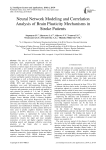
Neural network modeling and correlation analysis of brain plasticity mechanisms in stroke patients
Статья научная
The aim of this research is the study of pathogenic signs, prognostically significant for the outcome of the disease and restoration of impaired functions at various stages of recovery after a stroke. This work describes a new method of applying a group of artificial neural network algorithms for each of the criteria and for each period of rehabilitation, and it is aimed at analyzing the structural and functional support of motor and higher cognitive functions, including speech and language as well as brain plasticity after ischemic stroke. The functional magnetic resonance imaging (fMRI, DTI) and clinical data machine learning algorithms were used. Self-organizing Kohonen and probabilistic neural network-based models with different structures and parameters were developed and applied for each criterion for periods of 3, 6, and 12 months of rehabilitation. For correlation analyses and modeling additional classifiers, we used: Decision Tree (DT), Support Vector Machine (SUM), k-Nearest Neighbor (KNN) clustering, and Logistic Regression (LR). In the performance evaluation, sensitivity, specificity, accuracy, error rate, and f-measure were used. The using of clinical parameters and mathematical modeling for analysis of brain plasticity mechanisms in stroke patients allowed in some cases to predict cognitive functions within the accuracy of 85-97%. Moreover, it is shown that the functional systems is represented by various brain structures, its synchronous activity and structural connectivity ensures the rapid and most complete restoration of motor and higher cognitive functions, including speech and language (effective post-stroke plasticity of the brain) after a course of neurorehabilitation.
Бесплатно
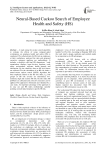
Neural-Based Cuckoo Search of Employee Health and Safety (HS)
Статья научная
A study using the cuckoo search algorithm to evaluate the effects of using computer-aided workstations on employee health and safety (HS) is conducted. We collected data for HS risk on employees at their workplaces, analyzed the data and proposed corrective measures applying our methodology. It includes a checklist with nine HS dimensions: work organization, displays, input devices, furniture, work space, environment, software, health hazards and satisfaction. By the checklist, data on HS risk factors are collected. For the calculation of an HS risk index a neural-swarm cuckoo search (NSCS) algorithm has been employed. Based on the HS risk index, IHS four groups of HS risk severity are determined: low, moderate, high and extreme HS risk. By this index HS problems are allocated and corrective measures can be applied. This approach is illustrated and validated by a case study. An important advantage of the approach is its easy use and HS index methodology speedily pointing out individual employee specific HS risk.
Бесплатно
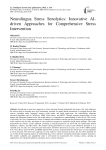
Neurolingua Stress Senolytics: Innovative AI-driven Approaches for Comprehensive Stress Intervention
Статья научная
Introducing an innovative approach to stress detection through multimodal data fusion, this study addresses the critical need for accurate stress level monitoring, essential for mental health assessments. Leveraging diverse data sources—including audio, biological sensors, social media, and facial expressions—the methodology integrates advanced algorithms such as XG-Boost, GBM, Naïve Bayes, and BERT. Through separate preprocessing of each dataset and subsequent feature fusion, the model achieves a comprehensive understanding of stress levels. The novelty of this study lies in its comprehensive fusion of multiple data modalities and the specific preprocessing techniques used, which improves the accuracy and depth of stress detection compared to traditional single-modal methods. The results demonstrate the efficacy of this approach, providing a nuanced perspective on stress that can significantly benefit healthcare, wellness, and HR sectors. The model's strong performance in accuracy and robustness positions it as a valuable asset for early stress detection and intervention. XG-Boost achieved an accuracy rate of 95%, GBM reached 97%, Naive Bayes achieved 90%, and BERT attained 93% accuracy, demonstrating the effectiveness of each algorithm in stress detection. This innovative approach not only improves stress detection accuracy but also offers potential for use in other fields requiring analysis of multimodal data, such as affective computing and human-computer interaction. The model's scalability and adaptability make it well-suited for incorporation into existing systems, opening up opportunities for widespread adoption and impact across various industries.
Бесплатно
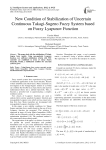
Статья научная
This paper deals with the stabilization of Takagi-Sugeno fuzzy models. Using non-quadratic Lyapunov function, new sufficient stabilization criteria with PDC controller are established in terms of Linear Matrix Inequality. Finally, a stabilization condition for uncertain system is given.
Бесплатно
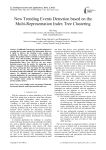
New Trending Events Detection based on the Multi-Representation Index Tree Clustering
Статья научная
Traditional Clustering is a powerful technique for revealing the hot topics among Web information. However, it failed to discover the trending events coming out gradually. In this paper, we propose a novel method to address this problem which is modeled as detecting the new cluster from time-streaming documents. Our approach concludes three parts: the cluster definition based on Multi-Representation Index Tree (MI-Tree), the new cluster detecting process and the metrics for measuring a new cluster. Compared with the traditional method, we process the newly coming data first and merge the old clustering tree into the new one. Our algorithm can avoid that the documents owning high similarity were assigned to different clusters. We designed and implemented a system for practical application, the experimental results on a variety of domains demonstrate that our algorithm can recognize new valuable cluster during the iteration process, and produce quality clusters.
Бесплатно
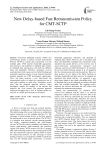
New delay-based fast retransmission policy for CMT-SCTP
Статья научная
Concurrent Multipath Transfer (CMT) uses multi-homing feature of Stream Control Transmission Protocol (SCTP) to transfer data concurrently over the multiple paths. CMT provides bandwidth aggregation, fault tolerance, and reliability in multipath data transfer. In multipath data transmission, each path has different delay and bandwidth. Therefore, destination receives unordered data which causes receiver buffer blocking and unwanted congestion window (cwnd) reduction. Both the problem degrades the CMT performance significantly. Thus, this paper proposes a new delay-based fast retransmission policy to adjust the transmission rate of each path according to path delay. Simulation results show that the proposed approach achieves better throughput, reduces the number of the timeout and improves the cwnd growth. The proposed approach improved throughput up to 16% in variable packet loss and 18% in variable network delay environment.
Бесплатно
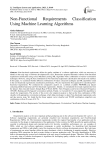
Non-Functional Requirements Classification Using Machine Learning Algorithms
Статья научная
Non-functional requirements define the quality attribute of a software application, which are necessary to identify in the early stage of software development life cycle. Researchers proposed automatic software Non-functional requirement classification using several Machine Learning (ML) algorithms with a combination of various vectorization techniques. However, using the best combination in Non-functional requirement classification still needs to be clarified. In this paper, we examined whether different combinations of feature extraction techniques and ML algorithms varied in the non-functional requirements classification performance. We also reported the best approach for classifying Non-functional requirements. We conducted the comparative analysis on a publicly available PROMISE_exp dataset containing labelled functional and Non-functional requirements. Initially, we normalized the textual requirements from the dataset; then extracted features through Bag of Words (BoW), Term Frequency and Inverse Document Frequency (TF-IDF), Hashing and Chi-Squared vectorization methods. Finally, we executed the 15 most popular ML algorithms to classify the requirements. The novelty of this work is the empirical analysis to find out the best combination of ML classifier with appropriate vectorization technique, which helps developers to detect Non-functional requirements early and take precise steps. We found that the linear support vector classifier and TF-IDF combination outperform any combinations with an F1-score of 81.5%.
Бесплатно
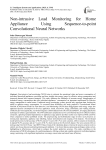
Статья научная
Non-intrusive load monitoring (NILM) aims to estimate the operational states and power consumption of individual household appliances, providing real-time insights into energy usage for effective energy management and improved demand side response strategies. This study addresses the challenge of accurate energy disaggregation of household energy consumption data into individual appliances’ consumption, an important requirement for effective energy management in smart homes. Traditional energy monitoring systems provide only aggregate data, limiting the ability to optimize energy consumption. To overcome these difficulties, this study proposes a Convolutional Neural Network (CNN)-based model for Non-Intrusive Load Monitoring (NILM) that disaggregates total energy usage into appliance-specific consumption for five key appliances: kettle, microwave, fridge, dishwasher, and washing machine. Unlike the previous approaches, our model integrates a hybrid dataset from UK-DALE and REFIT, leveraging data fusion techniques to enhance generalization. The CNN architecture employed uses five convolutional layers for effective feature extraction, capturing temporal dependencies in appliance usage patterns and thus results in an improved MAE and SAE when compared to similar published results. The preprocessing and hybridization stage involves such processes as missing data imputation, appliance state labelling, feature normalization and merging of the datasets. The developed model achieved an overall accuracy of 98.3% and an F1-score of 81.7% in seen scenarios, while in unseen environments, it attained 96.5% accuracy and an F1-score of 58.1% when tested on the UK-DALE dataset. The seen scenario refers to testing using UK-DALE House 1 and REFIT House 2 data of the validation dataset, whereas the unseen scenario involves entirely new house data not used during training and validation. It is shown that post-processing techniques reduce errors, highlighting its effectiveness, which help to enhance the model's predictive accuracy. This study contributes to the advancement of NILM technologies by combining datasets, offering a robust and scalable solution for individual appliace energy monitoring, with significant implications on energy conservation and smart home efficiency.
Бесплатно
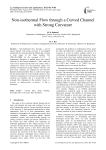
Non-isothermal Flow through a Curved Channel with Strong Curvature
Статья научная
Non-isothermal flow through a curved square channel with strong curvature is investigated numerically by using the spectral method and covering a wide range of the Dean number, Dn, 100≤Dn≤6000 for the curvature δ=0.5. A temperature difference is applied across the vertical sidewalls for the Grashof number , where the outer wall is heated and the inner one cooled. After a compressive survey over the parametric ranges, two branches of asymmetric steady solutions with two- and four-vortex solutions are obtained by the Newton-Raphson iteration method. Then, in order to investigate the non-linear behavior of the unsteady solutions, time evolution calculations as well as power spectrum of the solutions are obtained, and it is found that in the unsteady flow undergoes in the scenario “steady → periodic → multi-periodic → chaotic”, if Dn is increased.
Бесплатно
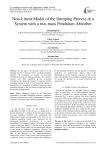
Non-linear model of the damping process in a system with a two-mass pendulum absorber
Статья научная
In this paper, the dynamic behavior of the damping system is analyzed with a two-mass pendulum absorber, the equations of motion of non-linear mechanical systems are built accordingly. AFC equation systems have been identified in the non-linear formulation. To obtain the frequency response, the Ritz averaging method is used. A new numerical method of determining the parameters of optimal tuning two-mass pendulum absorber in the non-linear formulation has been Proposed and implemented.
Бесплатно
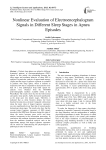
Nonlinear Evaluation of Electroencephalogram Signals in Different Sleep Stages in Apnea Episodes
Статья научная
Distinct sleep phases are related to different dynamical patterns in electroencephalogram (EEG) signals. In this article, the relationship between the sleep stages and nonlinear behavior of sleep EEG is explored. In particular, analysis of approximate entropy (ApEn) and the largest Lyapunov exponent is evaluated in patients with sleep apnea, which is defined as respiratory flow that is suspended or decreased for more than 10 s. The pathological sleep EEG signals for analysis were obtained from the MIT-BIH polysomnography database available online at the PhysioBank. The results show that for the both normal and apneic sleep epochs, ApEn decreased significantly as the sleep goes into deeper stages. Therefore, it indicated that as sleep becomes deeper, the brain function becomes less activated. Compared with normal sleep, the mean value of largest lyapunov exponents was also significantly lower than that of normal epochs during deep sleep stages. The results also show that the average largest lyapunov exponents of EEG signals increased in the REM state. Because during this stage of sleep, the cortex becomes more active and more neurons incorporate in the information processing. In conclusion, the nonlinear dynamical measures obtained from the nonlinear dynamical analysis such as the approximate entropy and largest lyapunov exponents can be useful for characterizing the physiological or pathological states of the brain.
Бесплатно
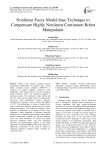
Nonlinear Fuzzy Model-base Technique to Compensate Highly Nonlinear Continuum Robot Manipulator
Статья научная
Refer to this research, a gradient descent optimization methodology for position fuzzy- model based computed torque controller (GDFCTC) is proposed for highly nonlinear continuum robot manipulator. The main problem of the pure computed torque controller (CTC) was equivalent problem in uncertain systems. The simulation results exhibit that the CTC works well in certain system. To eliminate the continuum robot manipulator system’s dynamic; Mamdani fuzzy inference system is design and applied to CTC. This methodology is based on applied fuzzy logic in equivalent nonlinear dynamic part to estimate unknown parameters. This relatively controller is more plausible to implement in an actual real-time when compared to other techniques of nonlinear controller methodology of continuum arms. Based on the gradient descent optimization method, the PD-gain updating factor has been developed in certain and partly uncertain continuum robots. The new techniques proposed and methodologies adopted in this paper supported by MATLAB/SIMULINK results represent a significant contribution to the field of design an optimized nonlinear computed torque controller for continuum robots.
Бесплатно

